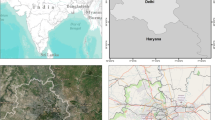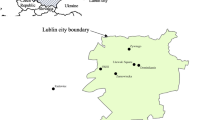Abstract
Air temperature was monitored at 13 sites across the urban perimeter of a Brazilian midsize city in winter 2011. In this study, we show that the urban heat island (UHI) develops only at night and under certain weather conditions, and its intensity depends not only on the site's land cover but also on the meteorological setting. The urban heat island intensity was largest (6.6 °C) under lingering high-pressure conditions, milder (3.0 °C) under cold anticyclones and almost vanished (1.0 °C) during the passage of cold fronts. The cooling rates were calculated to monitor the growth and decay of the UHI over each specific synoptic setting. Over four contiguous days under the effect of a lingering high-pressure event, we observed that the onset of cooling was always at about 2 h before sunset. The reference site attained mean cooling rate of −2.6 °C h−1 at sunset, whilst the maximum urban rate was −1.2 °C h−1. Under a 3-day cold anticyclone episode, cooling also started about 2 h before sunset, and the difference between maximum rural (−2.0 °C h−1) and urban (−1.0 °C h−1) cooling rates diminished. Under cold-front conditions, the cooling rate was homogeneous for all sites and swang about zero throughout the day. The air temperature has a memory effect under lingering high-pressure conditions which intensified the UHI, in addition to the larger heat storage in the urban area. Cold anticyclone conditions promoted the development of the UHI; however, the cold air pool and relatively light winds smoothed out its intensity. Under the influence of cold fronts, the urban fabric had little effect on the city's air temperature field, and the UHI was imperceptible.








Similar content being viewed by others
References
Avissar R (1992) Conceptual aspects of a statistical-dynamical approach to represent landscape subgrid-scale heterogeneities in atmospheric models. J Geophys Res 97:2729–2742
Camara G, Souza RCM, Freitas UM, Garrido J (1996) SPRING: integrating remote sensing and GIS by object-oriented data modelling. Comput Graph 20(3):395–403
Cavalcanti IFA, Kousky VE (2009) Frentes frias sobre o Brasil (in Portuguese). In: Silva Dias MAF, Cavalcanti IFA, Ferreira NJ, Justi da Silva MGA (eds) Tempo e clima no Brasil. Oficina de Textos, São Paulo, pp 135–148
Crush J, Frayne B (2011) Urban food insecurity and the new international food security agenda. Dev South Afr 28(4):527–544
Duh J-D, Shandas V, Chang H, George LA (2008) Rates of urbanisation and the resiliency of air and water quality. Sci Total Environ 400:238–256
Ferreira MJ, Oliveira AP, Soares J (2010) Anthropogenic heat in the city of São Paulo. Braz Theor Appl Climatol 104(1–2):43–56. doi:10.1007/s00704-010-0322-7
Frazer L (2005) Paving paradise: the peril of impervious surfaces. Environ Health Perspect 113(7):A456–A462
Frich P, Alexander LV, Della-Marta P, Gleason B, Haylock M, Klein Tank A, Peterson T (2002) Global changes in climatic extremes during the 2nd half of the 20th century. Clim Res 19:193–212
Gedzelman SD, Austin S, Cermak R, Stefano N, Partridge S, Queensberry S, Robinson DA (2003) Mesoscale aspects of the urban heat island around New York City. Theor Appl Climatol 75:29–42
Giles DB, Balafouts C, Maheras P (1990) Too hot for comfort: the heatwaves in Greece in 1987 and 1988. Int J Biometeorol 34:98–104
Haeger-Eugensson M, Holmer B (1999) Advection caused by the urban heat island circulation as a regulating factor on the nocturnal urban heat island. Int J Climatol 18:681–700
Hart MA, Sailor DJ (2009) Quantifying the influence of land use and surface characteristics on spatial variability in the urban heat island. Theor Appl Climatol 19:975–988
Hathway EA, Sharples S (2012) The interaction of rivers and urban form in mitigating the urban heat island effect: a UK case study. Build Environ 58:14–22
Hekkenberg M, Benders RMJ, Moll HC, Schoot Uiterkamp AJM (2008) Indications for a changing electricity demand pattern: the temperature dependence of electricity demand in the Netherlands. Energ Policy 37:1542–1551
Hirano Y, Fujita T (2012) Evaluation of the impact of the urban heat island on residential and commercial energy consumption in Tokyo. Energy 37:371–383
Holmer B, Thorsson S, Eliasson I (2007) Cooling rates, sky view factors and the development of intra-urban air temperature differences. Geogr Ann A 89:237–248
Institute for Applied Economic Research (Ipea) (2008) http://www.redbcm.com.br/arquivos/bibliografia/pesquisa%20ipea.pdf. Accessed 2 Jun 2013
IPCC (2012) Summary for policymakers. In: Barros V, Stocker TF, Qin D, Dokken DJ, Ebi KL, Mastrandrea MD, Mach KJ, Plattner G-K, Allen SK, Tignor M, Midgley PM, Field CB (eds) Managing the risks of extreme events and disasters to advance climate change adaptation. a special report of Working Groups I and II of the Intergovernmental Panel on Climate Change. Cambridge University Press, Cambridge, pp 1–19
Jauregui E, Romales E (1996) Urban effects on convective precipitation in Mexico city. Atmos Environ 30:3383–3389
Jauregui E (1997) Heat island development in Mexico city. Atmos Environ 31:3821–3831
Jonsson P, Bennet C, Eliasson I, Lindgren ES (2004) Suspended particulate matter and its relations to the urban climate in Dar es Salaam, Tanzania. Atmos Environ 38:4175–4181
Kidder SQ, Essenwanger OM (1995) The effect of clouds and wind on the difference in nocturnal cooling rates between urban and rural areas. J Appl Meteorol 34:2440–2448
Kim YH, Baik JJ (2002) Maximum urban heat island intensity in Seoul. J Appl Meteorol 41:651–659
Kim YH, Baik JJ (2005) Spatial and temporal structure of the urban heat island in Seoul. J Appl Meteorol 44:591–605
Kolokotroni M, Davies M, Croxford B, Bhuiyan S, Mavrogianni A (2010) A validated methodology for the prediction of heating and cooling energy demand for buildings within the urban heat island: case-study of London. Sol Energy 84:2246–2255
Kolokotroni M, Giridharan R (2008) Urban heat island intensity in London: an investigation of the impact of physical characteristics on changes in outdoor air temperature during summer. Sol Energy 82:986–998
Kusaka H, Kondo H, Kikegawa Y, Kimura F (2001) A simple single-layer urban canopy model for atmospheric models: comparison with multi-layer and slab models. Bound-Layer Meteorol 104:261–304
Kusaka H, Kimura F (2004) Thermal effects of urban canyon structure on the nocturnal heat island: numerical experiment using a mesoscale model coupled with an urban canopy model. J Appl Meteorol 43:1899–1910
Lobell D, Bonfils C (2008) The effect of irrigation on regional temperatures: a spatial and temporal analysis of trends in California. J Clim 21:2063–2071
Martilli A (2002) Numerical study of urban impact on boundary layer structure: sensitivity to wind speed, urban morphology and rural soil moisture. J Appl Meteorol 41:1246–1266
Matzarakis A, Nastos PT (2011) Human-biometeorological assessment of heat waves in Athens. Theor Appl Climatol 105:99–106
Nastos PT, Matzarakis A (2012) The effect of air temperature and human thermal indices on mortality in Athens. Theor Appl Climatol 108:591–599
Nkemdirim L, Truch P (1978) Variability of temperature fields in Calgary, Alberta. Atmos Environ 12:809–822
Nkemdirim LC (1980) A test of lapse rate/wind speed model for estimating heat island magnitude in an urban airshed. J Appl Meteorol 19:748–756
O'Meara M (1999) Reinventing cities for people and the planet. Worldwatch paper 147. Worldwatch Institute, Washington
Oke TR, Maxwell GB (1975) Urban heat island dynamics in Montreal and Vancouver. Atmos Environ 9:191–200
Oke TR (1987) Boundary layer climates. Methuen, New York
Pepin N, Benthan D, Taylor K (1999) Modelling lapse rates in maritime uplands of northern England: implications for climate change. Arct Antarc Alp Res 31:151–164
Pantavou K, Theoharatos G, Mavrakis A, Santamouris M (2011) Evaluating thermal comfort conditions and health responses during an extremely hot summer in Athens. Build Environ 46:339–344
Polidoro M, Lollo JA, Barros MVF (2011) Environmental impacts of urban sprawl in Londrina, Paraná, Brazil. J Urban Environ Eng 5:73–83
Population Division of the Department of Economic and Social Affairs of the United Nations Secretariat (2007) World urbanization prospects: the 2007 revision. http://www.un.org/esa/population/publications/wup2007. Accessed 3 Mar 2013
Rodríguez-Yi JL, Shimabukuro YE, Rudorff BFT (2000) Image segmentation for classification of vegetation using NOAA-AVHRR data. Int J Remote Sens 21(1):167–172
Ryu Y-H, Baik J-J (2012) Quantitative analysis of factors contributing to urban heat island intensity. J Appl Meteorol Clim 51:842–854
Sacks W, Cook B, Buenning N, Levis S, Helkowski J (2009) Effects of global irrigation on the near-surface climate. Clim Dyn 33:159–175
Sarrat C, Lemonsu A, Masson V, Guedalia D (2006) Impact of urban heat island on regional atmospheric pollution. Atmos Environ 40:1743–1758
Searle SY, Turnbull MH, Boelman NT, Schuster WSF, Yakir D, Griffin K (2012) Urban environment of New York City promotes growth in northern red oak seedlings. Tree Physiol 32:389–400
Satyamurty P, Mattos LF (1989) Climatological lower tropospheric frontogeneis in the midlatitudes due to horizontal deformation and divergence. Mon Weather Rev 117:1355–1364
Shiklomanov IA, Rodda JC (2003) World water resources at the beginning of the twenty-first century. Cambridge University Press, Cambridge
Spronken-Smith RA (1994) Energetics and cooling in urban parks. Ph.D. Thesis, University of British Columbia
Sugawara H, Narita K, Kim MS (2009) Cooling effect by urban river. The 7th International Conference on Urban Climate; 29 June–3 July 3, Yokohama, Japan
Suzuki C (1999) A climatological study of the cooling effect of urban rivers on heat island phenomena. Tokyo Metropolitan University, Dissertation
Taha H (1997) Urban climates and heat islands: albedo, evapotranspiration, and anthropogenic heat. Energ Build 25:99–103
Taha H, Akbari H, Rosenfeld A, Huang J (1988) Residential cooling loads and the urban heat island—the effects of albedo. Build Environ 23:271–283
Teuling AJ, Sonia I, Seneviratne SI, Stöckli R, Reichstein M, Moors E, Ciais P, Luyssaert S, van den Hurk B, Ammann C, Bernhofer C, Dellwik E, Gianelle D, Gielen B, Grünwald T, Klumpp K, Montagnani L, Moureaux C, Sottocornola M, Wohlfahrt G (2010) Contrasting response of European forest and grassland energy exchange to heatwaves. Nat Geosci 3:722–727
Unger J (1996) Heat island intensity with different meteorological conditions in a medium-sized town: Szeged, Hungary. Theor Appl Climatol 54:147–151
Unger J, Sümeghy Z, Zoboki J (2001) Temperature cross-section features in an urban area. Atmos Environ 58:117–127
Unger J (2004) Intra-urban relationship between surface geometry and urban heat island: review and new approach. Clim Res 27:253–264
Upmanis H, Eliasson I, Lindqvist S (1998) The influence of green areas on nocturnal temperatures in a high latitude city (Göteborg, Sweden). Int J Climatol 18:681–700
Velazquez-Lozada A, Gonzalez JE, Winter A (2006) Urban heat island effect analysis for San Juan, Puerto Rico. Atmos Environ 40:1731–1741
Yague C, Zurita E, Martinez A (1991) Statistical analysis of the Madrid urban heat island. Atmos Environ 25B:327–332
Zhao SQ, Da LJ, Tang ZY, Fang HJ, Song K, Fang JY (2006) Ecological consequences of rapid urban expansion: Shanghai, China. Front Ecol Environ 4(7):341–346
Acknowledgments
The authors would like to thank Fundação Araucária (grant number 470/2010) for funding the air temperature sensors used in this study. G. Coraiola is an undergraduate research bursary financed by CNPq (grant number 555768/2010-4). We thank those individuals and companies that hosted the temperature sensors during the measurement campaign, namely the students of the Federal Technology University of Paraná, the managers of IATE Clube Londrina, Lessence and Boulevard Park buildings and State University of Londrina (UEL). EMBRAPA Soja, IAPAR, SIMEPAR and INFRAERO are acknowledged for furnishing meteorological data. The authors express their sincere appreciation to the two anonymous reviewers who offered very relevant suggestions to improve the quality of this work.
Author information
Authors and Affiliations
Corresponding author
Rights and permissions
About this article
Cite this article
Targino, A.C., Krecl, P. & Coraiola, G.C. Effects of the large-scale atmospheric circulation on the onset and strength of urban heat islands: a case study. Theor Appl Climatol 117, 73–87 (2014). https://doi.org/10.1007/s00704-013-0989-7
Received:
Accepted:
Published:
Issue Date:
DOI: https://doi.org/10.1007/s00704-013-0989-7




